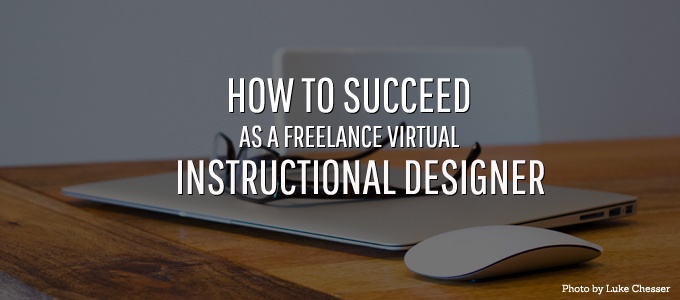Many of us are now embracing the virtual lifestyle in our careers. And we’re finding there are great benefits. Without a long commute, we find more time for a better work-life balance, so we can spend more time with friends and family and explore our hobbies. We also put less wear and tear on cars, while doing a small part to protect the environment.
That said, being a successful freelance virtual instructional designer is not as easy as setting up a computer in your home office. I have worked as an instructional designer (ID) both in an in-house office environment and as a freelancer working virtually. I have also interviewed and managed many virtual ID freelancers in my role at SweetRush. I have lived through and understand all too well the differences in the two environments, and how being a successful freelancer takes a special mindset. In-house, you are an employee; to be a successful freelancer, you need an entrepreneurial mindset (or at least demonstrate some entrepreneurial behaviors).
In this two-part series, I will share insights on what I look for when interviewing potential IDs for our engagements and some tips that kept me consistently busy when I was a freelancer—even during some lean years when it was challenging, and so many of my peers struggled to find work. Here in part 1, I’ll cover landing projects, and part 2 will focus on behaviors to exhibit once you get assigned to a project team.
How to Be a Successful Freelance Virtual Instructional Designer: Eight Tips for Landing Projects
1. Have your pitch ready.
Always have a polished response ready when someone asks what you do for a living. What makes your ID work unique? What gets you excited about instructional design? What’s in your secret sauce that keeps clients coming back for more? You never know who you might meet in a social setting.
Every new person you meet is an opportunity to network, as long as it’s done with sincerity. You have don’t walk around with your réesumée at cocktail parties or the coffeehouse, but do have business cards on you at all times with your contact info and website. Be sure to have a pen as well to get other people’s contact info if they don’t have cards.
2. Be prepared for interviews.
Review the website and social media pages of the company and the background of the people who will interview you (LinkedIn® profile, blog, etc.). Ask questions about or comment on areas of interest to you; this shows your ability to be thorough and pay attention to detail. If you are not totally prepared and cannot conduct yourself well in an interview, it does not bode well for your ability to connect with subject matter experts.
3. Be honest about your skills and experience.
Do not inflate your skill set. This is not a recipe for success for you—or the client. Freelancers do not typically have 100% of the skills listed in a job description, and hiring managers make decisions based on a combination of your soft skills, actual experience, and ability to demonstrate how you can confidently develop any of the needed skills you are lacking.
General rule of thumb: You should you have at least 50% of the qualifications listed in the ad. If there are certain skills that keep coming up that you don’t have, such as being proficient in Storyline® or other authoring tools, get further training for future opportunities.
4. Offer course samples and references during the interview process, even if they’re not requested.
What makes you stand out from the crowd? Make certain your portfolio sparkles. Ask for some help from a graphic designer or artist friend to help create a visually appealing landing page to house your samples. Remember to respect your client’s confidentiality.
5. Offer to do a video conference for the interview.
In-person interviews are not the norm for virtual opportunities due to distance, and we miss out on the face-to-face connection with phone interviews. Tools like Skype® and Google Hangouts™ offer free solutions. For more tips on video interviews, check out my colleague Misha Milshtein’s blog on avoiding a “weak handshake” in your virtual interview.
6. Send thank-you notes to everyone who interviews you.
At minimum, send a thank-you email. I interview a lot of individuals, and only about 20% thank me or express enthusiasm after the interview. I, like most interviewers, do tend to remember the candidates who reach out after the interview. It’s a courtesy, and something that can make you stand out from the crowd.
7. Continue to educate yourself on the industry and recent trends.
Attend conferences and webinars. For additional low-budget ideas, check out another blog of mine on continuing your instructional design education.
8. Spend some time each day without fail, even just 15 minutes, taking action toward landing new gigs or enhancing your skill set.
Need some ideas? Check out this list:
- Read an industry article.
- Research a training/e-learning company.
- Tweak your résumé or pitch.
- Review job boards.
- Obtain references from previous jobs or projects.
- Update your LinkedIn profile with keywords that make it easy for clients to search for you.
Any and all positive daily action creates momentum toward success.
Look out for Part 2 of this blog series, where I’ll focus on what to do once you’ve landed a project—all of those positive behaviors will put you at the top of your clients’ lists.
Do you have any tips to share on what makes you a successful freelance virtual instructional designer? Feel free to post a comment about your experiences!
For more tips on how to be a rock star instructional designer, check out Catherine's blog at SweetRush.com!










